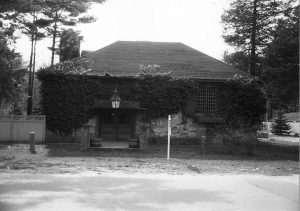In 1998, the Sippican Historical Society commissioned an architectural survey of Marion’s historic homes and buildings. The survey was funded one-half by the Sippican Historical Society and one-half by the Massachusetts Historical Commission. Due to the limits of funding, not all of the historic buildings were surveyed, but over 100 were catalogued and photographed. The results of the survey are in digital form on the Massachusetts Historical Commission’s website and in four binders in the Sippican Historical Society’s office (and at the Marion Town Clerk’s office).
Marion (Old Rochester) is one of the oldest towns in the United States, and the Sippican Historical Society maintains an extensive collection of documentation on its historic buildings. The Sippican Historical Society will preview one building a week so that the residents of Marion can understand more about its unique historical architecture.
This installment features 46 Spring Street. The Old Stone Studio at 46 Spring Street was built in 1820 and is significant as a rare surviving storage facility associated with the early 19th-century salt industry in Marion. By 1860, it housed Captain Allen’s petroleum oil refinery. However, it is most known as the “Old Stone Studio,” when the building was purchased by Richard Watson Gilder, the editor of Century Magazine, as a studio for his artist wife Helena deKay Gilder. In the 1880s and 1890s, the Gilders hosted a salon within this building, which attracted well-known writers, artists, actors, architects, musicians, politicians, sculptors, and philanthropists. The roster of persons in attendance at the Gilders’ theatrical performances, poetry readings, and musical performances included many celebrities, including Stanford White, who designed the Old Stone Studio’s chimney addition in 1883.
